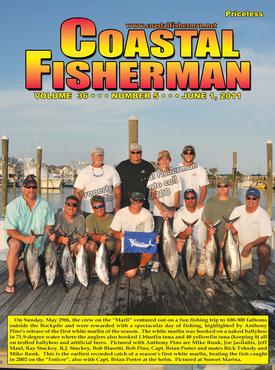


Article by Capt. Mark Sampson
 Even though we don’t see too many of them shooting around local bay waters, most fishermen are well aware of what a “bass boat” is all about. Averaging 16 to 20-feet long, they are somewhat specialized boats designed primarily with the freshwater bass fisherman in mind. Sporting fast hulls and big outboard motors, modern bass boats can almost be considered a cross between some sort of race boat and a high-tech fishing machine.
Even though we don’t see too many of them shooting around local bay waters, most fishermen are well aware of what a “bass boat” is all about. Averaging 16 to 20-feet long, they are somewhat specialized boats designed primarily with the freshwater bass fisherman in mind. Sporting fast hulls and big outboard motors, modern bass boats can almost be considered a cross between some sort of race boat and a high-tech fishing machine.
Often bass boats are well equipped with all kinds of livewells, bait tanks, rod lockers, built in tackle boxes, fish finders, oxygen meters, temperature gauges, pedestal seats and so forth. Above all else, one accessory that is found on almost every bass boat is the electric trolling motor. Trolling motors are so commonplace on bass boats that it might be next to impossible to find such a vessel without one.
Electric trolling motors are typically mounted on the bow of the boat by way of a bracket that allows the motor to be tilted up and locked out of the water when the unit is not being used. When needed, the motor is easily pivoted into the water and is ready for service.
The title “trolling motor” may be a bit misleading because most of the time the motor is not used for trolling as much as it is for positioning or moving the boat little bits at a time. Since they are usually mounted on the bow and may be rotated 360- degrees, these motors are extremely efficient at twisting and turning a boat in tight locations. At the same time, the electric motors produce very little sound, which often allows anglers the opportunity to approach fish that might otherwise be spooked by a noisy outboard.
So what’s all this have to do with local bay fishing? Actually, more than you may think. While electric trolling motors are still rare sights on bay fishing boats, they’re certainly showing up with greater frequency, a trend that may well be induced by new fishing options being pursued by local anglers.
As anglers discover that there’s a whole lot more options to bay fishing than simply “bottom bouncing” for flounder, many find themselves using techniques like plugging, jigging or fly casting. All require precision casting and makes boat positioning a very critical component for success.
After watching how effectively a local angler was able to maneuver his own boat around the inlet jetty, I realized when I was rigging a boat for bay fishing charters, that a trolling motor was something I just had to have. At that time I had never owned an electric motor, so I did a bit of research to determine what the best brand and model would be to fit my needs. It didn’t take long to discover that, for saltwater use, either the “Great White” series made by Motor Guide or the “Riptide” series made by Minn Kota was the way to go. I chose the Great White - imagine that.
Since my 19-foot center console boat is a good bit higher out of the water and heavier than the average bass boat, I needed a motor with a lot of thrust and a long shaft. The exact model I chose produces 67 pounds of thrust and has a 60-inch shaft.
Originally, I thought I’d only use the trolling motor on fly fishing charters, but the more I used it, the more new applications I found for the trolling motor. For example, when I am drift fishing down a channel and suddenly find that we’re getting too close to another boat, pier or sandbar, it’s nice to be able to hit a button and move over just enough to clear the obstacle without ever having to start up the main engine.
The trolling motor is a great way to hold the boat in position when I don’t want to drift away from a particular fishing area too quickly. With 67 pounds of thrust I can buck all but the strongest currents. The little motor also allows us to meander in and out of the bridge pilings whether casting plugs to rockfish or slinging baits to sea bass and tautog.
Finally, when my little “Fish’n Fly” ends up in water that’s too shallow for the big motor to operate (yes I’ve been known to whack a sandbar too), I can adjust the trolling motor to where it’s operating just below the surface and easily move back to the channel - without ever getting my feet wet!
All in all, the electric trolling motor has become a valuable addition to my inshore fishing equipment and has opened up a world of new fishing options. It has definitely helped me put more fish in the boat. I wonder what other kind of secrets those freshwater bass guys are keeping from us!
Captain Mark Sampson is an outdoor writer and captain of the charter boat “Fish Finder”, docked at the Ocean City Fishing Center.